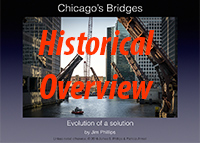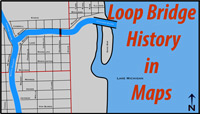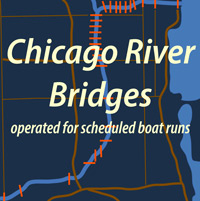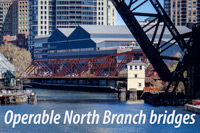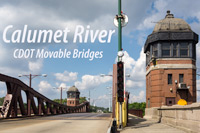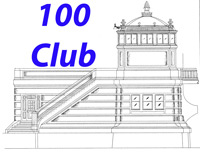Louis Koncza
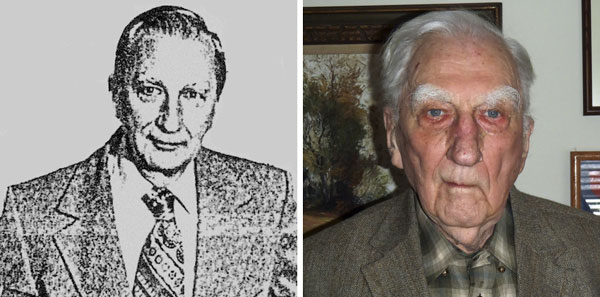
Louis Koncza in 1979 (image from the November 1979 issue of Midwest Engineer) and today
Louis Koncza worked in the Chicago Public Works Department from 1967 - 1992. I met with Mr. Koncza at his home in December 2012. Our conversation focused on his engineering career, but included other events in his life.
He began our conversation by saying that he “... never thought much about what happened forty years ago, but looking back on it I see it was kind of unusual … I worked at 3 places in 8 or 9 different positions. I applied twice, the rest I was told to take it over.”
Louis emigrated to the U.S. from Europe in 1949. He was studying architecture when the paperwork was approved to come to the U.S. His initial years in this country were marked by hard work and determination which eventually led to an engineering degree from University of Illinois, Urbana in 1952.
Louis was working for Boynton Engineers on the repairs of the Scherzer rolling lift bridge at Randolph St. in 1967, when he was approached by the Commissioner of Public Works, Milton Pikarski, to take over the Chief Bridge Engineer duties at Chicago Public Works (CPW). The current engineer, Morris Krausman, had been taken seriously ill and Krausman had put in a good word with Pikarski about Louis' skills.
Surprised at being approached on such a high level, Koncza was initially unsure that he was in fact being seriously pursued for the job. Subsequent meetings convinced him and he assumed the duties of the Chief Bridge Engineer in March of 1967.
The bridge division was staffed with “true” engineers – that is, personnel that wanted to do engineering work and not the coordinating work needed to oversee the division. Louis thinks his coordinating skills and his interactions with Krausman are what helped him get the job. Marshall Suloway, the Chief Engineer, introduced Louis to the bridge group and later told Louis that he thought the “oldtimers” would not accept him as their leader. It took about two years of transition, but the bridge division did work together as a team under Koncza's leadership.
In 1973, CPW personnel was shifting again. Milton Pikarski was appointed to be the CTA Commissioner, Marshall Suloway moved to the Commissioner of Public Works, and Suloway's job, the Chief Engineer position became vacant. Suloway called Louis into his office and announced that Louis was now the Chief Engineer. Unsure he really wanted it, Koncza reluctantly accepted it on a temporary basis. After a meeting with Mayor R. J. Daley, Louis was convinced to take the job.
Politics and Chicago seem to go hand-in-hand. As far as Koncza's experience is concerned, it never overtly affected his work. That's not to say he didn't have to be mindful of political issues and be able to use his coordinating/people skills in different ways. One such instance was during the design of the Belmont bridge over the North Branch of the Chicago River.
Economics is a primary driver in engineering projects. In the case of the Belmont bridge, an effort was made to shorten the span to reduce costs. Audubon Society representatives met with Louis to point out that the shortened span of this bridge forced raccoons populating the area to cross the street rather than pass under the bridge, thus increasing their chances of being hit by a car. Louis pointed out the cost issue and that the extra money was not in the budget.
Not entirely satisfied with their discussions with Louis, the Audubon Society representatives visited the chief IDOT engineer next (IDOT had oversight over the funding). In the meeting with IDOT, they mentioned the possibility of involving the governor in the matter.
Disputes involving the city and/or state executive branches in a public forum are generally not beneficial to a project. In this case, however, some additional funds were found without having to elevate the matter to the public level. The bridge design was modified somewhat so that the raccoons could safely pass under the bridge during most circumstances. During heavy rains, though, they are on their own.
Louis' tenure as Chief Engineer at CPW covered the “inter-Daley” period of Chicago politics. There were seven mayors (one of which served a week) from 1976 to 1989. This presents an interesting problem for large public works projects and the people given the responsibility for them. These projects have long planning, design, and construction periods (up to 10 years).
The Illinois Central air rights project developed the area bounded by N. Michigan Ave., the Chicago River, Lake Michigan, and E. Randolph St. It entailed design and construction of the tri-layer street system, the design and construction of the Columbus Dr. bridge, the re-alignment of Lake Shore Dr., and the addition of the second deck to the Lake Shore Dr. bridge. This was the most extensive project undertaken during Koncza's tenure at CPW and was completed in the "inter-Daley" period.
Most civil works projects have supporters and opponents. If there is a consistency in the mayor's office, a project need only be approved / justified once. When administrations change during the life of a project however, opponents may sense an opportunity to revisit, and possibly, reverse the approval of the project. With six mayors passing through the office during this period, Louis found himself presenting the merits and defending its funding in the budget to each administration. In this respect, the IC air rights became “his” project.
The two newest downtown bridges were completed during Koncza's tenure as City Engineer. The Columbus Dr. bridge was dedicated in 1982 during Mayor Jane Byrne's term of office. Koncza remembers Mayor Byrne for her enthusiasm for public acknowledgement of ground breaking and ribbon-cutting ceremonies. So it was that the Columbus Dr. bridge was opened with much fanfare.
The same could not be said about the current bridge at Randolph St., which opened in 1984. With Mayor Byrne no longer in office and Mayor Washington in the midst of the “Council wars,” there was little interest in grand ribbon cutting ceremonies. With a one paragraph announcement in the newspaper, the traffic barricades were removed early one morning and traffic flowed across the bridge.
I asked Louis if there was a project that he was especially proud of. His answer was the Copernicus monument in front of the Adler Planetarium. The monument was erected in 1973 in celebration of the 500th anniversary of Copernicus' birth. Louis was involved in various engineering and coordinating tasks associated with the monument. His work on this project was in addition to his other duties with CPW and was a true labor of love.
Louis retired from CPW in 1992 after 25 years of service.
Louis Koncza passed away on December 31, 2013 at the age of 91.

